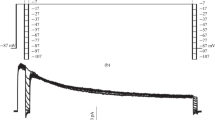Abstract
Single-channel currents from Na+-dependent K+ channels (KNa) were recorded from cell-attached and inside-out membrane patches of cultured avian trigeminal ganglion neurons by means of the patchclamp technique. Single-channel properties, such as the high elementary conductance and the occurrence of subconductance levels, were unchanged after the patches had been excised from the cells, indicating that they are not under the control of soluble cytoplasmic factors. In cellattached recordings at the cell resting potential the degree of KNa activity, measured as the probability of the channel being open, P o, was low in most cases (around 0.01) and similar to that observed in the inside-out configuration when the bath solution contained concentrations of Na+ around 30 mM and of K+ close to the physiological intracellular levels. However, in some cell-attached patches P o was high (around 0.2) and comparable to the values measured in cell-free recordings with high Na+ concentrations in the bath (100 mM). The excision of a highactivity patch in the presence of 30 mM Na+ resulted in a fall of P o in about 20 s, which is consistent with the wash-out of a soluble cytoplasmic molecule. After the excision all KNa displayed a similar Na+ sensitivity, irrespective of the degree of activation observed in the cellattached mode. In inside-out patches the P o values observed in the presence of either low or high concentrations of Na+ in bath solutions were not modified by internal Ca2+ (0.8–8.5 μM). The variable degree of KNa activation observed in cell-attached recordings suggests that either internal Na+ concentrations reach very high levels close to the membrane, or soluble factor(s) are involved in the modulation of KNa activity: under such conditions, the Na+-activated K+ current may contribute to the maintenance of the resting membrane potential and to control neuronal membrane excitability.
Similar content being viewed by others
References
Bader CR, Bernheim L, Bertrand D (1985) Sodium-activated potassium current in cultured avian neurones. Nature 317:540–542
Bührle CP, Sonnhof U (1983) Intracellular ion activities and equilibrium potentials in motoneurones and glia cells of the frog spinal cord. Pflügers Arch 396:144–153
Colquhoun D, Sigworth FJ (1983) Fitting and statistical analysis of single-channel records. In: Sakmann B, Neher E (eds) Single-channel recording. Plenum, New York, pp 191–263
Cook DL, Hales CN (1984) Intracellular ATP directly blocks K+ channels in pancreatic B-cells. Nature 311:271–273
Dryer SE (1991) Na+-activated K+ channels and voltage-evoked ionic currents in brain stem and parasympathetic neurones of the chick. J Physiol (Lond) 435:513–532
Dryer SE, Fujii JT, Martin AR (1989) A Na+-activated K+ current in cultured brain stem neurones from chicks. J Physiol (Lond) 410:283–296
Egan TM, Dagan D, Kupper J, Levitan IB (1992) Properties and run-down of sodium-activated potassium channels in rat olfactory bulb neurons. J Neurosci 12:1964–1976
Fischmeister R, Ayer Jr RK, De Haan RL (1986) Some limitations of the cell-attached patch clamp technique: a two electrode analysis. Pflügers Arch 406:73–82
Foehring RC, Schwindt PC, Crill WE (1989) Norepinephrine selectively reduces slow Ca2+- and Na+-mediated K+ currents in cat neocortical neurons. J Neurophysiol 61:254–256
French RJ, Wells JB (1977) Sodium ions as blocking agents and charge carriers in the potassium channel of the squid giant axon. J Gen Physiol 70:707–724
Grafe P, Rimpel J, Reddy MM, Ten Bruggencate G (1982) Changes of intracellular sodium and potassium ion concentrations in frog spinal motoneurons induced by repetitive synaptic stimulation. Neuroscience 7:3212–3220
Haimann C, Bernheim L, Bertrand D, Bader CR (1990) Potassium current activated by intracellular sodium in quail trigeminal ganglion neurons. J Gen Physiol 95:961–979
Hamill OP, Marty A, Neher E, Sakmann B, Sigworth FJ (1981) Improved patch-clamp techniques for high-resolution current recordings from cells and cell-free membrane patches. Pflügers Arch 391:85–100
Harootunian AT, Kao JPY, Eckhert BK, Tsien RT (1989) Fluorescence ratio imaging of cytosolic free Na+ in individual fibroblasts and lymphocytes. J Biol Chem 264:19458–19467
Hartung K (1985) Potentiation of a transient outward current by Na+ influx in crayfish neurones. Pflügers Arch 404:41–44
Kameyama M, Kakei M, Sato T, Shibasaki H, Matsuda H, Irisawa H (1984) Intracellular Na+ activates a K+ channel in mammalian cardiac cells. Nature 309:354–356
Luk H-N, Carmeliet E (1990) Na+ -activated K+ current in cardiac cells: rectification, open probability, block and role in digitalis toxicity. Pflügers Arch 416:766–768
Martell AE, Smith RM (1974) Critical stability constants. Plenum, New York
Martin AR, Dryer SE (1989) Potassium channels activated by sodium. Q J Exp Physiol 74:1033–1041
Pallotta BS, Helper JR, Oglesby SA, Harden TK (1987) A comparison of calcium-activated potassium channel currents in cell-attached and excised patches. J Gen Physiol 89:985–997
Partridge DL, Thomas RC (1976) The effects of lithium and sodium on the potassium conductance of snail neurones. J Physiol (Lond) 254:551–563
Sanguinetti MC (1990) Nai +-activated and ATP-sensitive K+ channels in the heart. In: Colatsky TJ (ed) Potassium channels: basic fuction and therapeutic aspects. Wiley-Liss, New York, pp 85–109
Schwindt PC, Spain WS, Crill WE (1989) Long-lasting reduction of excitability by a sodium-dependent potassium current in cat neocortical neurons. J Neurophysiol 61:233–244
Singer JJ, Walsh Jr JV (1984) Large conductance Ca++-activated K+ channels in smooth muscle cell membrane. Biophys J 45:68–70
Wang Z, Kimitsuki T, Noma A (1991) Conductance properties of the Na+-activated K+ channel in guinea-pig ventricular cells. J Physiol (Lond) 433:241–257
Author information
Authors and Affiliations
Rights and permissions
About this article
Cite this article
Haimann, C., Magistretti, J. & Pozzi, B. Sodium-activated potassium current in sensory neurons: a comparison of cell-attached and cell-free single-channel activities. Pflügers Arch 422, 287–294 (1992). https://doi.org/10.1007/BF00376215
Received:
Revised:
Accepted:
Issue Date:
DOI: https://doi.org/10.1007/BF00376215




